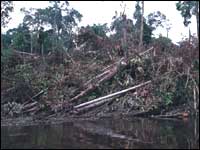Some years ago, well before many outside Denmark knew Bjorn Lomborg’s name, a group of his fellow faculty members at the University of Aarhus took the unusual step of developing a website specifically to warn the scientific community and others about flaws in his work. Appalled by Lomborg’s scientific pretensions and unfounded conclusions, these faculty members, including a former head of the Danish Academy of Sciences, actively disassociated themselves from him.
These faculty members did not want to be associated with Lomborg’s work because it is fundamentally flawed. The thesis of Lomborg’s book, The Skeptical Environmentalist, is that the environmental movement has overstated the magnitude of environmental threats. A serious test of this hypothesis would require a systematic review of the research output of the leading environmental groups, tabulating both the instances where they have overstated and where they have understated threats to the environment. This exercise would also include determining which threats identified by environmental groups turned out to be real and which did not. Finally, it would include tabulating those issues that environmentalists either missed entirely or identified only belatedly. Only with such an approach could one decide whether environmentalists as a group have overstated or understated the threats to our planet. In failing to take such an approach, Lomborg’s book becomes nothing more than a diatribe.

I have not undertaken such an assessment, but I have on occasion gone back to review the Worldwatch Institute’s State of the World reports, of which I was the senior author for 18 years. In doing so, I have been struck more by the issues that we understated or discovered after the fact than by those that we overstated or issues that turned out to be unimportant after all.
Lomborg’s fellow faculty members are concerned that his work does not satisfy basic academic standards. Other reviewers have pointed out that he has never published a single article in a refereed scientific journal. There may be a reason for that.
Earth in the Imbalance
Take Lomborg’s analysis of population problems. He dismisses the idea of population sustainability as largely meaningless because it is a local concept, dealing only with the local sustainability of support systems. Local imbalances between people and resources can be remedied, he says, either by international trade (shades of Julian Simon) or by people simply moving to cities. He describes the projected growth in Third World cities as though it were an unproblematic solution to local population and resource imbalances.

Cozy, not crowded.
It is sometimes possible to import goods and services when they are not locally adequate — but often it is not. For example, when the demand for firewood leads to deforestation, the cost of importing firewood or, indeed, any fuel, may be prohibitive. The usual alternative is to burn crop residues, thus depriving the soil of much-needed organic matter. Moreover, in some instances the resource system may be pushed to its limits not only locally but also globally, as with oceanic fisheries. At that point, we have a problem. As we look at oceanic fisheries, rangelands, forests, aquifers, and croplands, we see that these natural support systems are often overtaxed at both the regional and global level. As population increases, so does pressure on these systems.
While the goods that natural systems provide can sometimes be imported to locations where they are lacking, the services they provide often cannot. For example, if local forests are decimated, lumber can be imported, but the flood control that the forests provide cannot. Lomborg has difficulty dealing with the services that natural systems provide, just as Julian Simon did.
For these reasons, relocating people to cities or importing non-local goods does not solve the problems created by burgeoning populations.
Population Bummed
Lomborg’s protestations to the contrary, population growth is putting unprecedented pressure on natural systems. For example, the world’s forested area, measured in terms of healthy, productive stands of trees, is shrinking. According to recent meticulously detailed research by the World Resources Institute, the shrinkage and deterioration of the earth’s forests is apparently proceeding even faster than the United Nations Food and Agriculture Organization data suggest.

Forty-five years ago, I lived in a village in central India on the Deccan plateau. To reach the village, I had to travel from the nearest train station for hours on a dirt road in a bullock cart through heavily forested terrain. Like many other parts of India, the forests in this region have now largely disappeared, replaced in some cases by cropland, but more often by wasteland. One wonders if Lomborg has traveled in developing countries.
Lomborg dismisses concerns about the availability of water for an ever-increasing number of people, but his grasp of the issue is shallow at best and fails to adequately take into account the sustainable yield of aquifers. The depletion of aquifers is a new problem, one that has emerged only in the last half-century with the advent of diesel and powerful electrically driven pumps. Unfortunately, water tables are falling in major food-producing regions around the world, such as the North China Plain, the Punjab of India, and the southern Great Plains of the United States. When the aquifers are depleted, the pumping will necessarily be cut back to the rate of aquifer recharge. When you factor in the reality that most of the 3 billion-person increase in global population over the next half century will occur in countries that are already facing water shortages, you can begin to sense the dimensions of this fast-unfolding problem.
Analyzing environmental issues requires examining the interactions between the global economy, the earth’s ecosystems, and world political arrangements. Understanding any one of these systems is itself complicated, but trying to understand the ongoing and dynamic relationship among the three is incredibly difficult — and not something that yields to superficial analyses, such as those by Lomborg. Like his faculty colleagues who know him well, the rest of us would be wise to disassociate ourselves from his work.


